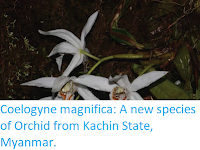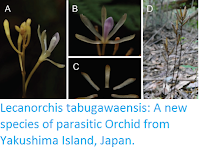Epidendroid Orchids, Epidendroideae, are the largest subfamily of
Orchids, with over 15 000 described species, more than all other Orchid
groups combined. The majority of these species are epiphytic (live on
other plants, typically in the canopy of rainforest trees), though
terrestrial forms are known. The group is found across the globe, with
the exception of the polar regions, the deserts of Africa, Arabia and
Australia, and the southern part of South America. The genus Govenia comprises about 24 species of geophytic (rock-dwelling) Orchids from South and Central America and the Caribbean, which grow from underground rhizomes (root-like stems) and produce racemes of small but showy flowers.
In a paper published in the journal Phytotaxa on 6 March 2018, Gerado Salazar of the Departamento de Botánica at the Universidad Nacional Autónoma de México, Adrián Fernández-Díaz of the Asociación Orizabeña de Orquideología, Carlos René Huerta-Alvízar of La Patrona, Rolando Jiménez-Machorro of the Herbario AMO, Lidia Cabrera, also of the Departamento de Botánica at the Universidad Nacional Autónoma de México, and David Jimeno-Sevilla of the Herbario at the Instituto Tecnológico Superior de Zongolica, describe a new species of Govenia from Veracruz State in Mexico.
The new species is named Govenia polychroma, meaning 'multi-coloured' in reference to the brightly coloured flowers of this species. The species is a herbaceous plant reaching 65−80 cm in height, producing two large leaves and an inflorescence with up to 40 small flowers from an underground rhizome. Flowers are produced from August to early October, and are yellow, magenta, purplish-magenta, white, and brown, producing a distinctive smell in the late afternoon.
The species grows on leaf mold near rocky outcrops at altitudes of between 850 and 1350 m in cloud forest. Only forteen specimens of this species were discovered, eleven at the base of a 20 m cliff adjacent to a coffee plantation, an area with no legal protection, and three within the Reserva del Bicentenario. For this reason Salazar et al. recommend that the species be treated as Critically Endangered under the terms of the International Union for the Conservation of Nature’s Red List of Threatened Species.
See also...
The new species is named Govenia polychroma, meaning 'multi-coloured' in reference to the brightly coloured flowers of this species. The species is a herbaceous plant reaching 65−80 cm in height, producing two large leaves and an inflorescence with up to 40 small flowers from an underground rhizome. Flowers are produced from August to early October, and are yellow, magenta, purplish-magenta, white, and brown, producing a distinctive smell in the late afternoon.
Govenia polychroma. Flowering plant in situ at Reserva del Bicentenario, Zongolica, Veracruz. David Jimeno-Sevilla in Salaza et al. (2018).
The species grows on leaf mold near rocky outcrops at altitudes of between 850 and 1350 m in cloud forest. Only forteen specimens of this species were discovered, eleven at the base of a 20 m cliff adjacent to a coffee plantation, an area with no legal protection, and three within the Reserva del Bicentenario. For this reason Salazar et al. recommend that the species be treated as Critically Endangered under the terms of the International Union for the Conservation of Nature’s Red List of Threatened Species.
Govenia polychroma. Flower. Rolando Jiménez-Machorro in Salaza et al. (2018).
See also...
Follow Sciency Thoughts on Facebook.








